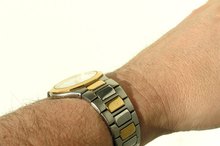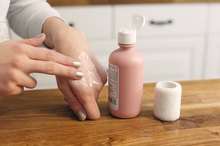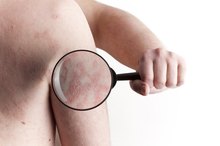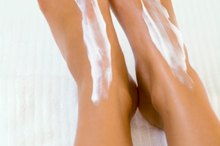How to Treat Tanning Bed Rash
Tanning is a popular pastime, but quite a few people get out of the tanning bed with more than a healthy glow. Tanning bed rash is a skin condition that is not uncommon among tanners. The rash consists of patches of small, extremely itchy, bumps that appear shortly after a tanning session. These rashes are uncomfortable but luckily they are fairly easy to treat.
How to Treat Tanning Bed Rash
Stop all tanning for the duration of the outbreak. Continuing to tan after noticing a tanning bed rash will often lead to the spread, or worsening, of the rash. It is important to let the irritated skin heal before returning to tanning.
How to Get Rid of Ringworm in Minutes
Learn More
Keep the rash area clean and dry. Wash daily using lukewarm water instead of hot water. Too much hot water can dry out and further irritate the rash. After washing, pat the rash dry instead of rubbing.
Use antibiotic ointment or cream to help fight the bacteria causing tanning bed rash. Apply a small amount of ointment to the rash and rub it completely into the skin to keep the area moist and protected. Reapply to clean skin as needed throughout the day for fastest results.
How to Avoid Scarring With Poison Oak
Learn More
Take an antihistamine (such as Benadryl) to treat itching and possible allergic reactions. Some tanning bed rashes are caused by an allergic reaction to cleaning supplies or tanning lotion. Using an antihistamine will combat any allergic reactions while stop itching, which, through scratching, often leads to the spread of rashes.
Identify the cause of the tanning bed rash. Over time even the best treatments lose effectiveness. Clean the tanning bed prior to use with hypoallergenic wipes to avoid skin reactions to cleansers used by the salon. Change tanning lotions and start using products designed for sensitive skin, containing no accelerators. Take breaks during tanning to wipe sweat from the tanning bed and your body to avoid rashes caused by clogged pores.
Warnings
If tanning bed rashes do not heal or worsen after one week, consult a doctor or dermatologist.
- Stop all tanning for the duration of the outbreak.
- Apply a small amount of ointment to the rash and rub it completely into the skin to keep the area moist and protected.
Related Articles
References
- Dr. David Bryant
- Healthcare Magic
- American Cancer Society. How Do I Protect Myself for Ultraviolet Rays?
- Food and Drug Administration. Sunless Tanners & Bronzers.
- Saraff, V., and N. Shaw. Sunshine and Vitamin D. Archives of Diseases in Children. 2016. 101(2):190-2. doi:10.1136/archdischild-2014-307214
- Kliegman, Robert M., Bonita Stanton, St Geme III Joseph W., Nina Felice. Schor, Richard E. Behrman, and Waldo E. Nelson. Nelson Textbook of Pediatrics. 20th Edition. Philadelphia, PA: Elsevier, 2015. Print.
Warnings
- If tanning bed rashes do not heal or worsen after one week, consult a doctor or dermatologist.
Writer Bio
Tameka McSpadden is a freelance writer with several years of professional experience. With both a Bachelor of Science in health care management and an associate degree in business administration from Bellevue University, McSpadden enjoys writing about all medical topics. She is currently preparing for a literary agency internship in North Georgia while attending various writing workshops.









